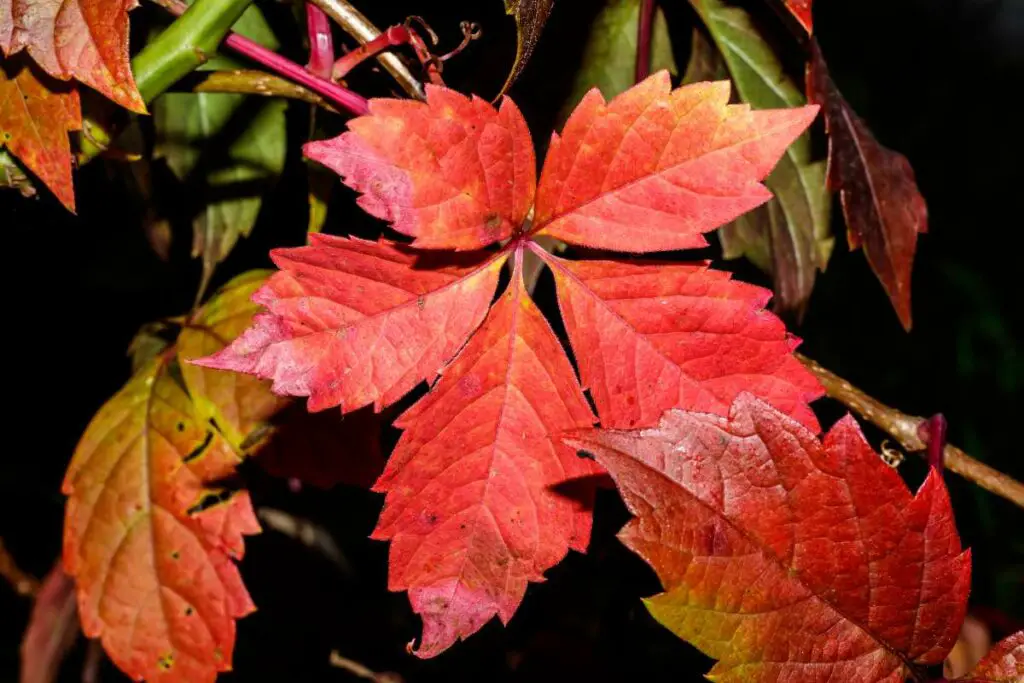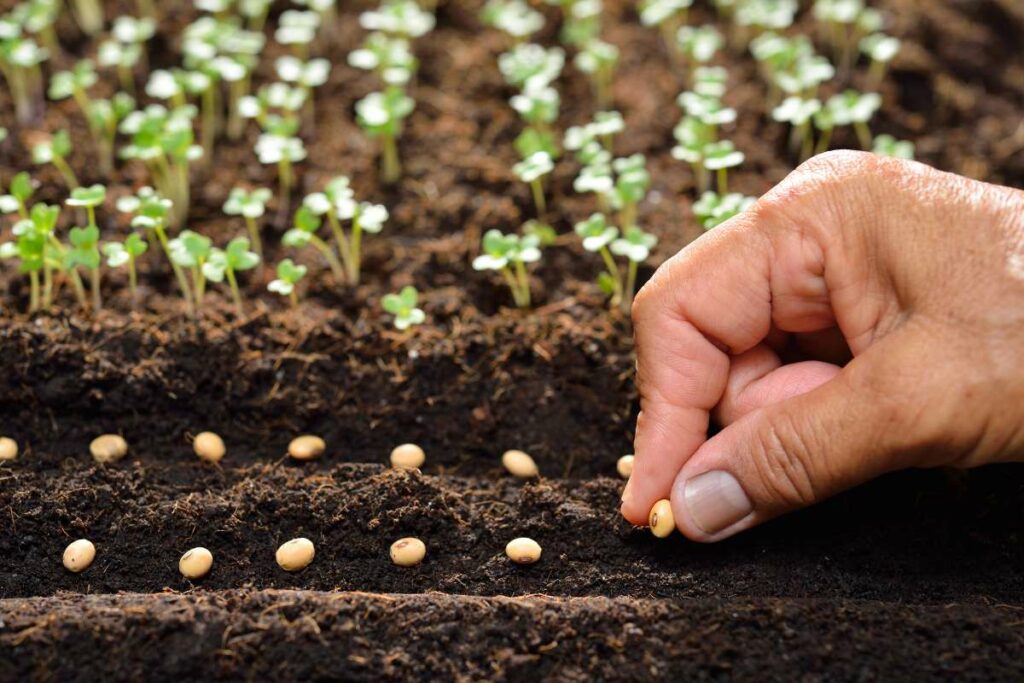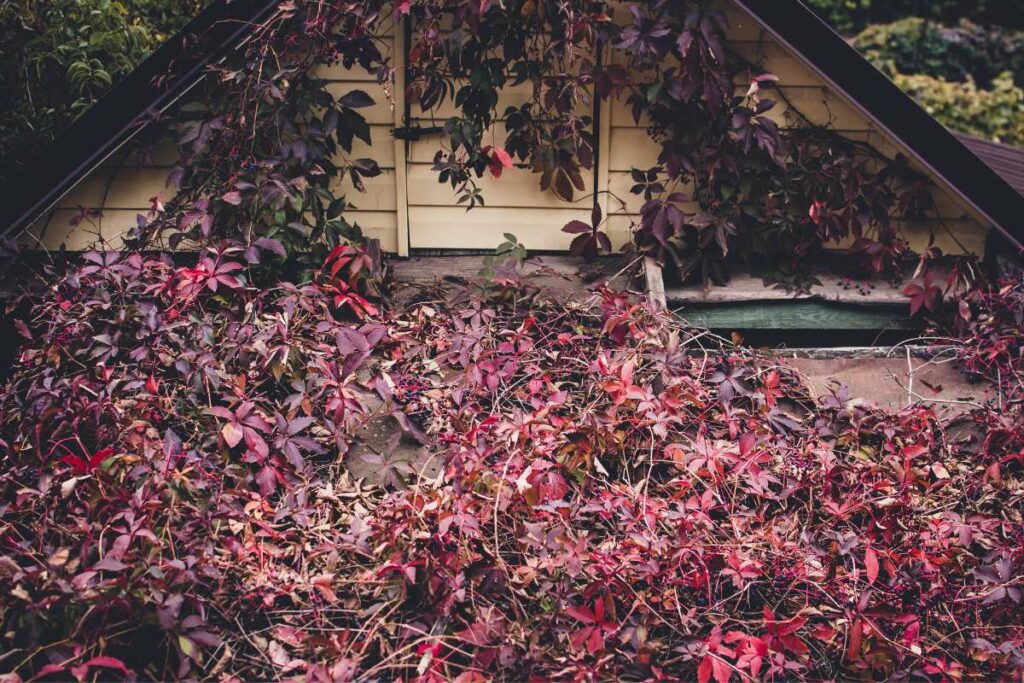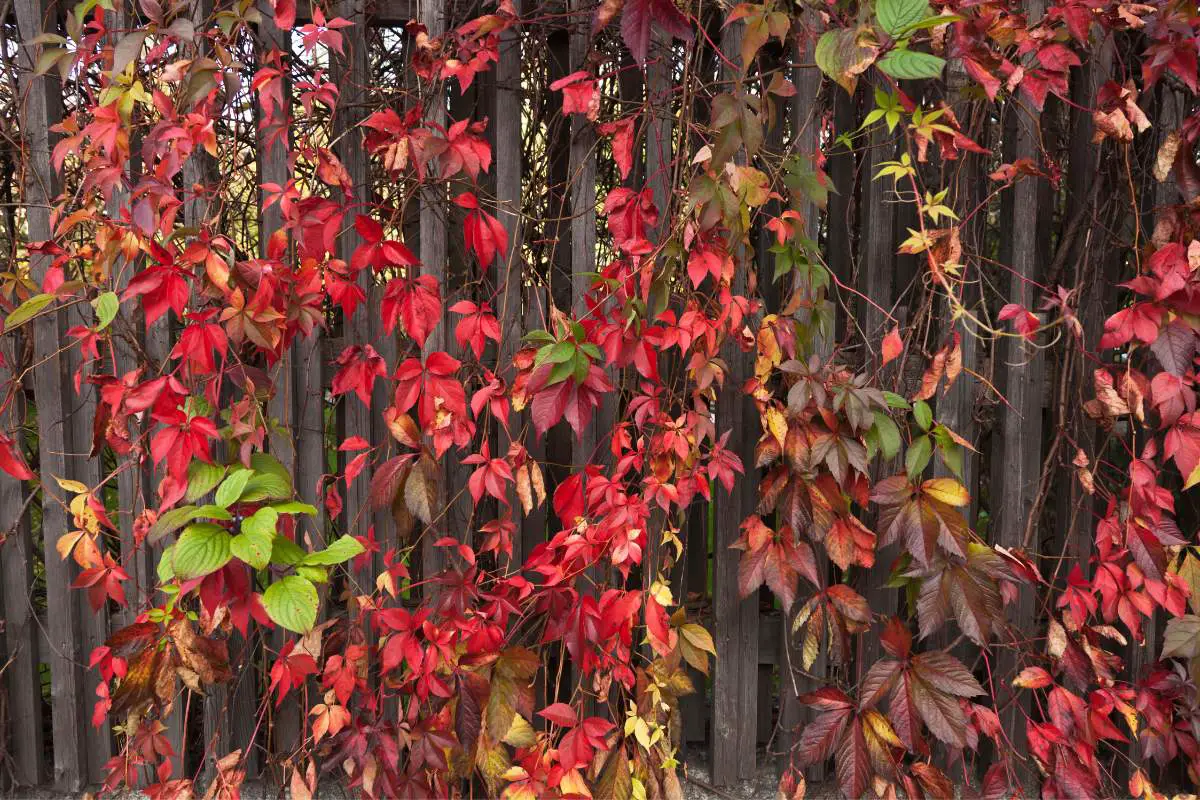If you’re looking for a fast-growing and vigorous vine to add to your garden, Virginia Creeper (Parthenocissus quinquefolia) is an excellent choice.
This beautiful vine is known for its stunning fall foliage and its ability to climb up walls, fences, and trellises. But to keep your Virginia Creeper looking its best, it’s important to know how to properly care for it.
In this Virginia Creeper maintenance and care guide, you’ll learn everything you need to know to keep your vine healthy and thriving.
From planting and watering to pruning and fertilizing, we’ll cover all the essential steps to ensure your Virginia Creeper looks its best.
Whether you’re a seasoned gardener or a beginner, this guide will help you get the most out of your Virginia Creeper.
Pros and cons of growing Virginia Creeper
Pro’s
- Easy to grow
- Fast-growing
- Attractive foliage
- Wildlife habitat
- Ever changing colors
Con’s
- If not controlled can be Invasive
- Can damage structures
- Can cause skin irritation
- Attracts pests
Planting Virginia Creeper
Planting Virginia Creeper is easy and straightforward. Follow these simple steps to ensure your vine thrives:
Choosing a Location
Virginia Creeper can grow in full sun or partial shade, but it prefers a location with some shade, especially in hotter climates.
It can also be grown as a ground cover or trained to climb a trellis or support structure, such as a fence or wall. Choose a location that has well-drained soil and is not prone to flooding.
Preparing the Soil
Before planting, prepare the soil by removing any weeds or grass in the planting area. Virginia Creeper prefers moist, well-drained soil, so consider adding compost or well-rotted manure to improve soil structure and drainage. If your soil is heavy clay, consider adding sand or perlite to improve drainage.

Planting the Vine
When planting, dig a hole that is twice as wide as the root ball and just as deep. Gently remove the plant from its container, being careful not to damage the roots.
Place the plant in the hole, backfill with soil, and gently tamp down to remove any air pockets. Water thoroughly to settle the soil around the roots.
It’s important to note that Virginia Creeper can be invasive and may damage structures if not pruned regularly. Consider planting it away from buildings or other structures if you are concerned about damage.
Plant Characteristics
If you’re looking for a versatile and low-maintenance vine plant, Virginia Creeper might be the perfect choice for you.
This deciduous vine is known for its vigorous growth, hardiness, and adaptability to various environments.
Here are some of the plant characteristics you should know:
| Characteristic | Description |
|---|---|
| Height | Virginia Creeper can grow up to 50 to 90 feet (15-27 m.) long. |
| Colour | The leaves of Virginia Creeper are usually green in the summer and turn red or purple in the fall. |
| Fruit Types | Virginia Creeper produces small blue-black berries that attract birds. |
| Leaf Shape | The leaves of Virginia Creeper are palmately compound, meaning they have five leaflets that radiate from a central point. |
| Botanical Name | Virginia Creeper’s botanical name is Parthenocissus quinquefolia. |
| Sun Exposure | Virginia Creeper can grow in full sun to partial shade. |
| Soil Types | Virginia Creeper prefers well-drained soil that is rich in organic matter. |
| Best Zones in USA | Virginia Creeper is hardy in USDA zones 3-9. |
Overall, Virginia Creeper is a beautiful and easy-to-grow vine that requires minimal maintenance. It can be used to cover walls, fences, and trellises, or as a ground cover.
With its stunning fall colors and attractive berries, it can add interest and beauty to any garden or landscape.
How to Grow Virginia Creeper From Seed
If you want to grow Virginia Creeper from seed, it’s important to start with fresh seeds that have been stratified.
Stratification involves exposing the seeds to cold temperatures for a period of time to break their dormancy.
You can stratify Virginia Creeper seeds by placing them in a plastic bag with some damp sand or peat moss and storing them in the refrigerator for 60-90 days.
Once the seeds have been stratified, you can plant them directly into the soil. Choose a location that receives full sun to partial shade and has well-draining soil.
Virginia Creeper can tolerate a wide range of soil types, but it prefers slightly acidic soil with a pH between 5.5 and 7.0.

Plant the seeds about 3/8 inch deep and keep them to no more than 10 per square foot. Provide deep watering once a week. The plant will grow quickly, and you can expect to see sprouts within 2-3 weeks of planting.
As the seedlings grow, make sure to thin them out so that each plant has enough space to grow. You can also fertilize the plants with a balanced fertilizer once a month during the growing season to encourage healthy growth.
It’s important to note that Virginia Creeper can be invasive in some areas, so make sure to keep an eye on the plants and remove any that are spreading too quickly.
Additionally, Virginia Creeper can be toxic to some animals, so make sure to keep it away from pets and livestock.
Virginia Creeper Maintenance
Virginia creeper is a fast-growing climbing vine that can quickly cover walls, fences, and trellises. Proper maintenance is essential to keep the plant healthy and looking its best.
In this section, we will discuss some important maintenance tasks that you should perform to ensure the health and vigor of your Virginia creeper.
Watering and Fertilizing
During its first growing season, Virginia creeper needs regular watering, with deep watering. Once the vine is established, it only needs occasional deep watering.
Water the plant when the soil is dry to the touch, but do not overwater it as this can lead to root rot.
Virginia creeper is not a heavy feeder, but you can fertilize it once a year in the spring to encourage healthy growth. Use a balanced fertilizer and follow the manufacturer’s instructions for application.
Vine Vitality All Purpose Fish & Kelp Liquid Fertilizer
Vine Vitality is perfect for Virginia creeper
- For Healthy, Responsible and Abundant Growing
- Makes up to 32 gallons
- No harmful chemicals
- N-P-K = 4.0 – 4.0 – 0.5
Pruning and Training
Pruning is an essential part of Virginia creeper maintenance. It is best to prune the plant in early spring before new growth begins.
Use sharp, clean pruning shears and cut outside the main stem to prevent injury to the plant.
Cut away small stems where they are getting unruly, but wait until early spring for large-scale cutting. You can also train the vine to grow in the direction you want by tying it to a trellis or support.
Pest and Disease Control
Virginia creeper is relatively pest and disease-resistant, but it can still be affected by some common problems.
Leafhoppers and scale insects can infest the plant, causing damage to the leaves and stems. To control these pests, you can use insecticidal soap or neem oil.
Fungal diseases such as powdery mildew and leaf spot can also affect the plant. To prevent these diseases, avoid overhead watering and ensure good air circulation around the plant.
Another important aspect of Virginia creeper maintenance is keeping gutters and downspouts clear of the plant.
The vine can quickly grow into gutters and clog them, causing water damage to your home. Regularly check and clear any growth from gutters and downspouts to prevent this problem.
Virginia Creeper in Autumn
As the cooler months approach, Virginia Creeper vines begin to transform into a stunning display of autumn colors. The leaves turn from their vibrant green to shades of red, orange, and yellow, making them a popular choice for fall landscaping.
Fall Color
The Virginia Creeper is known for its stunning fall foliage. The leaves turn a deep red in autumn, making it a popular choice for adding color to your garden or landscape.
The color change typically occurs in late September or early October and lasts for several weeks.
It is important to note that the intensity of the color can vary depending on the amount of sunlight the plant receives.
Virginia Creeper vines that are planted in full sun will have more vibrant colors than those planted in partial shade.

Fruits
In addition to its beautiful fall color, Virginia Creeper also produces small blue-black fruits in the autumn.
These fruits are a valuable food source for birds, making the plant a popular choice for birdwatchers.
However, it is important to note that the fruits are poisonous to humans and should not be consumed.
If you choose to leave the fruits on the vine, they will eventually dry out and fall off. If you prefer to remove them, it is best to do so before they dry out to prevent them from falling and creating a mess in your yard.
Overall, Virginia Creeper is a low-maintenance plant that can add beauty and color to your garden or landscape.
With proper care and maintenance, you can enjoy its stunning fall colors and provide a valuable food source for birds in the autumn.
Virginia Creeper Landscaping
Virginia Creeper is a versatile plant that can be used in a variety of landscaping settings.
It can be grown as a ground cover or a climbing vine, and it is a vigorous grower that can quickly cover large areas. Here are some tips for using Virginia Creeper in your landscaping:
Ground Cover
If you’re looking for a low-maintenance ground cover that will add color to your landscape, Virginia Creeper is a great choice.
It can grow up to 50 feet wide, making it perfect for covering large areas. It is also drought-tolerant, so it is ideal for areas with limited water.
When planting Virginia Creeper as a ground cover, it’s important to space the plants about 3 feet apart to give them room to spread out.
Once established, Virginia Creeper will quickly cover the ground, creating a lush carpet of green leaves. It is also a great plant for erosion control, as its roots help hold the soil in place.
Climbing Vine
Virginia Creeper is also a popular climbing vine that can be used to cover walls, fences, and trellises. It attaches itself to surfaces with adhesive pads and aerial tendrils, so it won’t damage the walls of your home.
If you’re looking to add color to a yellow wall, Virginia Creeper is a great choice. Its leaves turn a beautiful red in the fall, providing a stunning contrast against the yellow background.
When planting Virginia Creeper as a climbing vine, it’s important to provide support for the plant to climb on. You can use a trellis, fence, or even the walls of your home.
Once established, Virginia Creeper will quickly cover the surface, creating a beautiful green backdrop for your landscape.
Overwintering
If you live in a region with harsh winters, you may be wondering how to overwinter your Virginia Creeper.
The good news is that Virginia Creeper is hardy and can withstand cold temperatures. However, there are a few things you can do to help your plant survive the winter and thrive in the spring.
First, make sure your Virginia Creeper is healthy going into the winter. This means giving it plenty of water and fertilizer in the fall to help it build up its reserves.
You should also prune any dead or diseased branches to prevent them from becoming a problem later on.
Next, consider adding a layer of mulch around the base of your Virginia Creeper. This will help insulate the roots and protect them from freezing temperatures. You can use a variety of materials for mulch, including leaves, straw, or wood chips.
If you live in an area with heavy snowfall, you may also want to protect your Virginia Creeper from snow and ice damage.
One way to do this is to wrap the plant in burlap or a similar material. This will help prevent branches from breaking under the weight of heavy snow or ice.
Finally, be patient in the spring. Virginia Creeper may take a little longer to start growing in the spring than other plants, but it will eventually come back strong.
Once the weather warms up, remove any winter protection you added and give your plant a good pruning to encourage healthy growth.
FAQs
Virginia Creeper is a popular vine plant that is easy to grow and care for. However, like any other plant, you may have some questions about its maintenance and care.
Here are some of the most frequently asked questions about Virginia Creeper:
How often should I water my Virginia Creeper plant?
You should water your Virginia Creeper plant regularly, especially during the hot summer months. However, be careful not to overwater it, as this can lead to root rot. A good rule of thumb is to water it deeply once a week, or more often if the soil is dry to the touch.
How do I prune my Virginia Creeper plant?
Pruning is essential to maintain the health and shape of your Virginia Creeper plant. You should prune it in late winter or early spring, before new growth appears. Use sharp, clean pruning shears to remove any dead or damaged branches, and cut back any overgrown stems to promote new growth.
How do I propagate Virginia Creeper?
Virginia Creeper is easy to propagate from stem cuttings. Simply take a cutting from a healthy plant, dip the end in rooting hormone, and plant it in a pot with well-draining soil. Keep the soil moist and warm, and roots should start to form within a few weeks.
How do I control Virginia Creeper from spreading?
Virginia Creeper is a fast-growing plant that can quickly take over your garden if left unchecked. To control its spread, you can prune it regularly, remove any new shoots that appear, or plant it in a container. You can also use a barrier or a physical barrier to prevent it from spreading into unwanted areas.
How do I protect my Virginia Creeper from pests and diseases?
Virginia Creeper is a hardy plant that can be grown indoors if you provide it with the right conditions. It needs bright, indirect light, well-draining soil, and regular watering. However, keep in mind that it is a fast-growing plant that can quickly outgrow its container if not pruned regularly.
Finally
Conclusion and final thoughts ?
Now have a good understanding of Virginia Creeper maintenance and care! With proper care, your Virginia Creeper can thrive and be a beautiful addition to your garden or landscape.
By following these simple guidelines, you can enjoy the beauty of Virginia Creeper for years to come!
